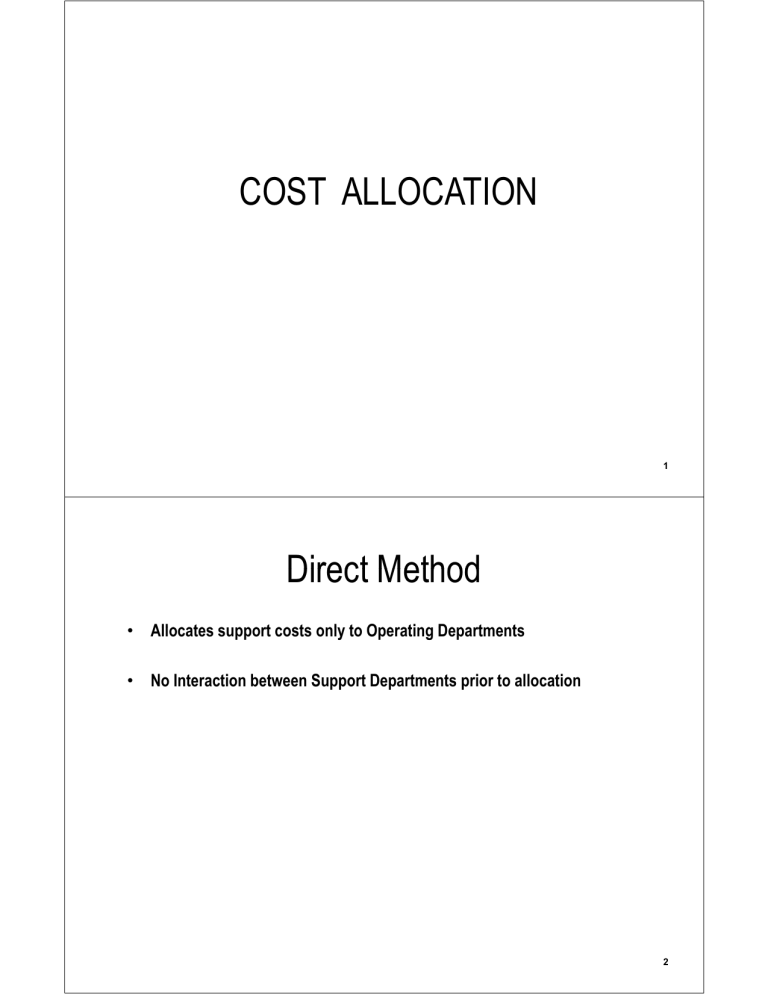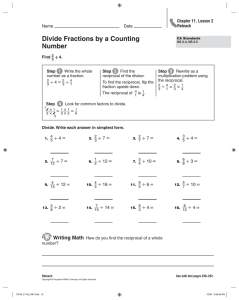
COST ALLOCATION 1 Direct Method • Allocates ssupport pport costs onl only to Operating Departments • No Interaction between Support Departments prior to allocation 2 Direct Method 3 Step-Down p Method • Allocates support costs to other support departments and to operating departments that partially recognizes the mutual services provided among all support departments • One-Way Interaction between Support Departments prior to allocation 4 Step-Down Method 5 Reciprocal Method ReciprocalMethod • Allocates Allocatessupportdepartmentcoststo support department costs to operatingdepartmentsbyfullyrecognizing themutualservicesprovidedamongall supportdepartments • FullTwoWayInteractionbetweenSupport Departments prior to allocation Departmentspriortoallocation 6 R i Reciprocal lM Method th d 7 Choosing Between Methods • Reciprocal is the most precise • Direct and Step-Down are simple to compute and understand • Direct Method is widely used 8 COST ALLOCATION PROBLEM (Direct, Step-Down, & Reciprocal Methods) 9 COST ALLOCATION PROBLEM (Direct, Step-Down, & Reciprocal Methods) A summary off the th fixed fi d andd variable i bl support-department td t t costs t ffollows: ll 10 DIRECT METHOD DATA Cost allocation computations: 11 STEPDOWN METHOD DATA Cost allocation computations: 12 RECIPROCAL METHOD DATA Cost allocation computations: 13 Footnotes: 14 Dual-Rate Method, Budgeted vs. Actual Costs, & Practical Capacity vs. Actual Quantities Chocolat Ch l t Inc. I is i a producer d off premium i chocolate h l t based b d in i Palo P l Alto. Alt The Th company has a separate division for each of its two products: dark chocolate and milk chocolate. Chocolat purchases ingredients from Wisconsin for its Dark Chocolate division and from Louisiana for its Milk Chocolate division. Both locations are the same distance from Chocolat's Palo Alto plant. Chocolat Inc. operates a fleet of trucks as a cost center that charges the di i i divisions for f variable i bl costs t (d (drivers i and d ffuel) l) and d fixed fi d costs t (vehicle ( hi l depreciation, insurance, and registration fees) of operating the fleet. Each division is evaluated on the basis of its operating income. Last year, the trucking g fleet had a practical p capacity p y of 50 round-trips p between the Palo Alto plant and the two suppliers. It recorded the following information: 15 Dual-Rate Method, Budgeted vs. Actual Costs, & Practical Capacity vs. Actual Quantities Chocolat,, Inc. decides to examine the effect of using g the dual-rate method for allocating g truck costs to each round-trip. At the start of the year, the budgeted costs were: Variable cost per round-trip $ 1,500 1 500 Fixed costs $40,000 The actual results at year-end for the 45 round-trips made were: Variable costs $60,750 Fixed costs $36,000 Total $96,750 16 1. Using the dual-rate method, what are the costs allocated to the Dark Chocolate Division and the Milk Chocolate Division when (a) variable costs are allocated using the budgeted rate per round-trip and actual round-trips used by each division and when (b) fixed costs are allocated based on the budgeted rate per round-trip and round-trips budgeted for each division? 17 2. From the viewpoint of the Dark Chocolate Division, what are the effects of using the d l t method dual-rate th d rather th than th th the single-rate i l t methods? th d ? The dual rate changes how the fixed indirect cost component is treated. By using budgeted trips made made, the Dark Chocolate Division is unaffected by changes from its own budgeted usage or that of other divisions. g rates and actual trips p are used for allocation ((see requirement q 1.b. of When budgeted problem 15-17), the Dark Chocolate Division is assigned the same $24,000 for fixed costs as under the dual-rate method because it made the same number of trips as budgeted. However, note that the Milk Chocolate Division is allocated $16,000 However $16 000 in fixed trucking costs under the dual-rate system, compared to $800 u 15 actual trips = $12,000 when actual trips are used for allocation. As such, the Dark Chocolate Division is not made to appear disproportionately more expensive than the Milk Chocolate Division simply because the latter did not make the number of trips it budgeted at the start of the year. 18 Reciprocal p Cost Allocation E - books, an online book retailer, has two operating departments-Corporate Sales and Consumer Sales-and two support departments - Human Resources and Information Systems. S stems Each sales department conducts cond cts merchandising and marketing operations independently. E - books uses number of employees to allocate Human Resources costs and processing time to allocate Information Systems costs. costs The following data are available for the year: 19 Reciprocal p Cost Allocation Consider E-books again. The controller of E-books reads a widely used textbook that states that “the reciprocal method is conceptually the most defensible.” He seeks your assistance. 20 1. Describe the key features of the reciprocal method. • The reciprocal allocation method explicitly includes the mutual services provided among all support departments. • Interdepartmental relationships are fully incorporated into the support department cost allocations. allocations 21 2. Allocate the support departments’ costs (Human Resources and Information S t Systems) ) tto th the ttwo operating ti ddepartments t t using i th the reciprocal i l method. th d 22 Reciprocal method using repeated iterations 23 3. In the case presented in this exercise, which method (direct, step-down, or reciprocal) i l) would ld you recommend? d? Why? Wh ? • The reciprocal method is more accurate than the direct and step-down methods when there are reciprocal relationships among support departments. • The reciprocal method is the preferred method, although the numbers for the year do not appear materially different across the alternatives. 24







